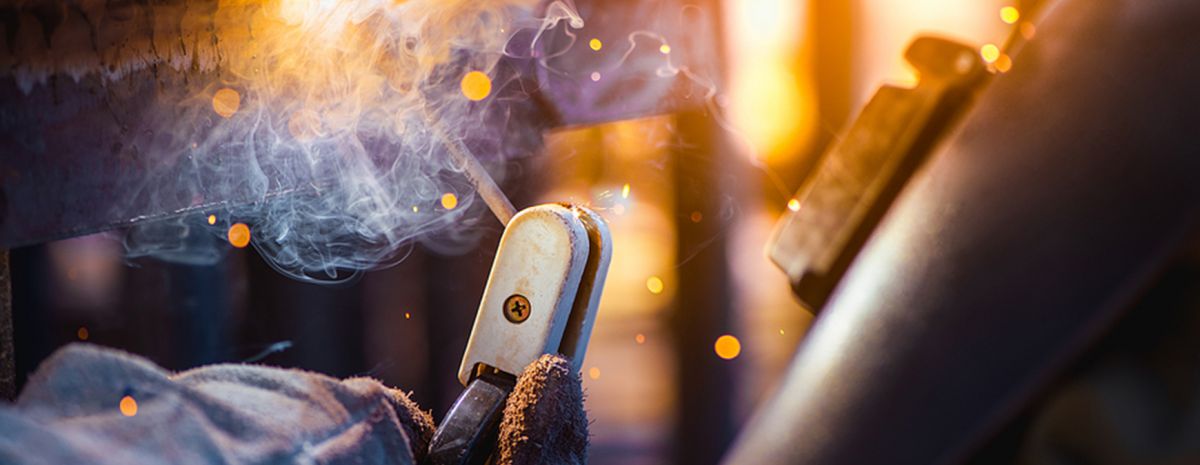TWS is a Great Training Option for Everyone
Learn more about how we can prepare you to advance your career.
Stick welding is one of the most commonly applied techniques in the family of arc welding processes.1 It’s likely one of the first processes you’ll learn about in your welding classes. And there are some important considerations for getting it right:
Should you push or pull the weld pool? When stick welding, you should always pull.
What’s the Difference Between Pushing and Pulling?
What are you pushing or pulling in the first place? These two welding techniques are spoken of in relation to the small pool of molten metal known as the weld pool. You’ll create a weld pool with most welding processes, spreading it across your work surface with your electrode to fuse the two pieces of metal.
When pushing, welders work behind their weld pool and push it with their welding electrode, creating the weld bead as they go. Pushing has the advantage of creating a shallower weld that covers a larger surface area. Depending on the project, this technique can result in a more durable weld than what’s offered by a pulling motion.
Have You Considered a Career in the Skilled Trades?
Fill out the form to recieve a no obligation info packet.
In contrast, pulling is when welders work in front of the pool, letting it fill behind their electrode to form the weld bead.2 One of the more pronounced benefits of using a pulling motion is greater visibility of your weld.3 This vantage point makes it easier to make minor adjustments as you go so you don’t end up having to repeat the weld.
While some welding processes offer more leeway when it comes to choosing between pushing and pulling, stick welding doesn’t fall into that category. Instead, stick welding demands strict and specific form in order to be performed correctly.
You Should Pull When Stick Welding
When stick welding, you need to use a pulling technique. To help remember this rule more easily, the welding community has created catchy rhymes such as “if there is slag, you must drag.” Slag is the solidified layer of flux that rests over the weld zone, and drag is simply used to refer to the motion used in the pulling technique.
Put in simpler terms, you should be pulling the rod towards you when using any welding process that produces slag. This includes submerged arc welding, electroslag welding, flux-cored arc welding and shielded metal arc welding (SMAW), more commonly known as stick welding.
3 Tips for Laying Down a Solid Stick Weld

Pulling instead of pushing is essential to a properly executed stick weld. However, it’s not the only part of the puzzle. Here are some other additional tips for creating an excellent stick weld.
1. Limit the Size of Your Weld Pool
A common problem new welders face when mastering stick welding is what’s known as the undercut. These imperfections located on the outer edges of a weld detract from the aesthetic appeal of your work while also producing a weak spot that can fail with the right amount of pressure.
To help limit the development of an undercut, manage the size of the weld pool. Reducing your speed and trying not to weave back and forth can help too.
2. Use the Right Arc Length
After the electrode is struck against the metal, make sure you have the right arc length. When stick welding, it’s advisable to match the arc length with the diameter of the electrode you’re using. For example, a ⅛” electrode would warrant a ⅛” arc length.
An excessively long arc length can result in a deep undercut or weld splatter while a short arc length might cause the electrode to stick.
3. Choose the Right Metal
Just like canvas influences an artist’s technique, the steel welders work with can impact the effectiveness of the welding process. When stick welding, it’s a good idea to stick with steel that isn’t rich in silicon or sulfur, such as 1025 or 1015 steel. Otherwise, your weldment could have a higher chance of cracking.
If you’re stuck with a less-than-ideal type of steel, using an electrode with a smaller diameter at a slower speed can help.
Welding Safety
The best welding technique in the world won’t help you much if you get hurt in the lab or shop. So, welding safety is perhaps the most important practice to observe. Fortunately, welding safety is one of the first things you’ll learn about in welding school.
1https://www.praxairusa.com/about-us/frequently-asked-questions/what-is-stick-welding
2https://weldingtroop.com/do-you-push-or-pull-when-stick-welding/
3https://www.weldingsuppliesfromioc.com/blog/push-or-pull-which-is-right/
This blog has been labeled as archived as it may no longer contain the most up-to-date data. For a list of all current blog posts, please visit our blog homepage at https://www.tws.edu/blog/







